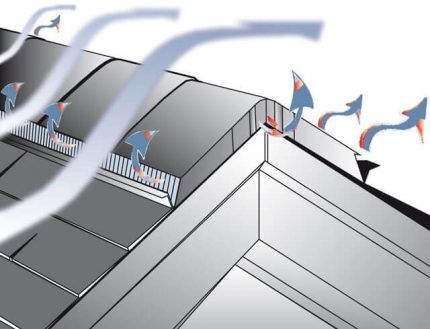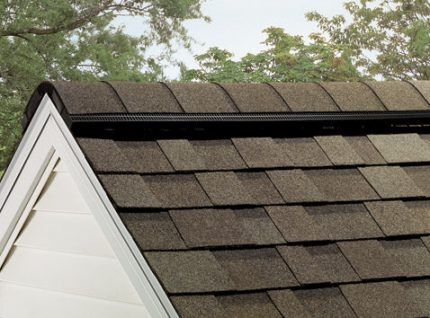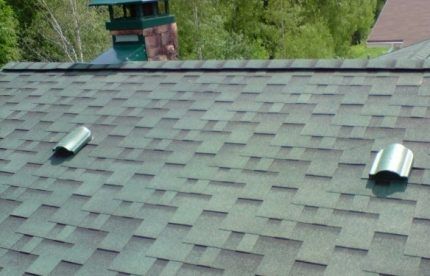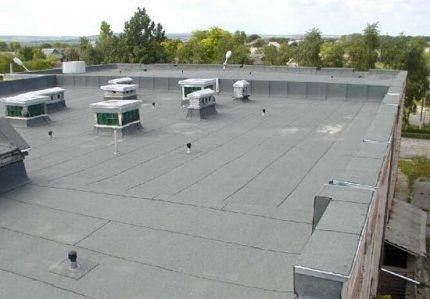Ventilation of roofs made of soft tiles: design and installation of soft roofs
Roofing made from soft tiles is known for its excellent performance characteristics, but it has the only drawback - the lack of sufficient ventilation.Thus, the regular accumulation of condensation under the roof destroys the insulation, wooden rafters and sheathing, which calls into question the safety of the building.
Agree, it is better to think about installing roof ventilation before purchasing a roofing covering, rather than spending a lot of money later on restoring the roof structure. Plus, ventilation of a soft tile roof will forever solve the problem of mold formation indoors. After all, such a neighborhood has never benefited anyone.
Before you start designing roof ventilation, you should study in more detail all methods of air exchange, including the installation features of each of them. Later in the article you will learn which type of ventilation is best to choose, and what rules are important to follow at the stage of designing and installing a ventilation system.
The content of the article:
Roof ventilation - why is it important?
Because due to sudden changes in air temperature, numerous evaporations inside the room and high air humidity, condensation forms in the under-roof space.
Thus, accumulated moisture penetrates the thermal insulation layer, which leads to a decrease in its effectiveness.

In addition, the lack of necessary air exchange leads to significant overheating of the roof in the hot season, which will make it unbearable to stay indoors.
Consequently, installing a roof ventilation system allows you to solve several problems at once, providing:
- sufficient flow of fresh air into under-roof space;
- stable temperature and humidity in the attic;
- reliable protection of the roof, ceilings and walls from mold formation;
- full functioning of the thermal insulation material.
Installing roof ventilation will significantly reduce the cost of heating or cooling the room, replacing the rafter system, or numerous attempts to combat fungus.
The ideal time to install a ventilation system is to replace the old covering with a new roof made of soft tiles.
Requirements for roof ventilation
Proper ventilation for soft tile roofs should be taken seriously to avoid the above problems.
First of all, you should remember the space between the base and insulation, to achieve which you will need to fill a beam 5 cm thick. In addition, it is important to ensure in advance that there are small holes at the bottom of the slope to ensure a sufficient flow of fresh air.

When installing a soft roof, do not forget about the holes for ridge ventilation and installation of aerators.
When installing the sheathing, it is important to take into account the need for gaps, which will ensure continuous circulation of fresh air. All these nuances must be thought out at the system design stage.
Types of roof ventilation
The shape and design of the roof completely determine the type of roof ventilation.If a roof made of soft tiles has a complex geometric surface, sufficient air exchange can only be ensured by installing ridge ventilation.
So, depending on the features of the construction of the house, there are two types of ventilation through the ventilation ridge:
- Spot. It is installed on separate sections of the ridge or slope, and has a mushroom-shaped shape. Such aerators are often integrated into the overall ventilation system of a building, but in some cases they can be equipped with a separate hood.
- Continuous. It is mounted along the entire ridge, and thereby ensures complete ventilation of the area under the roof space. Unlike a point system, continuous ventilation is more effective for soft roofs.
In this case, it is worth considering a continuous type of ventilation. Thus, the ridge element is a rigid plastic structure, which consists of a solid upper part in the shape of a corner, as well as perforated walls.

Ridge ventilation works by convection, in which warm air masses rise upward from the eaves, and cold air, in turn, is pulled down. In this case, the system has its own entry and exit zones.
Thus, fresh air penetrates into the under-roof space through the roof ventilation overhangs (from below), while the ridge aerator located at the top of the soft roof is the outlet for exhaust air.
Rules for installing a ridge system
Since the ridge option is the most reliable type of roof ventilation today, it is worth considering in more detail.
Regardless of the type of ridge aerator, all designs have the same structure and include the following components:
- protective barrier;
- connecting endings;
- partitions;
- structural ribs.
To install the structure, it is necessary to make several grooves in the ridge beam, 1.5 cm long. The distance between them should not be less than 30 cm. The marked grooves will subsequently be covered with a ridge element.

Today, ready-made structures for installing ridge ventilation can be purchased at any store, and the element is selected in accordance with the angle of the roof.
If you have a ready-made ridge product, you need to figure out how to install vents on a roof made of soft tiles:
- if the system is installed on a finished roof made of flexible tiles, then, first of all, you will need to dismantle the old ridge, partially disassembling the tiles;
- Next, you need to mark the new ridge aerator, and it is important to make an allowance of 1.5 cm from the top;
- at the next stage you will need a circular saw, with which you can make a neat cut, based on the markings;
- Flexible tiles will be nailed to solid areas, but in this case the partitions should be left open;
- The ridge aerator has special latches, through which the element will be connected to the roof ridge.Having installed the aerator using small latches, it will need to be secured using small self-tapping screws;
- for greater reliability, the end part of the aerator should be treated with silicone sealant;
- Next, the installed profile will need to be covered with soft tiles.
Despite the popularity of the “do-it-yourself” method, in some cases it will be more advisable to purchase a ready-made structure than to undertake its own manufacture.
The cost of ventilation ridge systems is not so high that you should try to save money on their purchase.

In large houses, in addition to continuous roof ventilation, a point ventilation system is also installed for soft tile roofs, since continuous roof ventilation is often not enough.
Consequences of lack of roof ventilation
If there is no ventilation system under a roof made of bitumen shingles, moisture may accumulate in the hollow space, which will cause the roof to rot, which means the strength of the structure will significantly decrease. In addition, the lack of proper air exchange will lead to the insulation getting wet, as a result of which its thermal insulation properties will be impaired.
Roof ventilation plays a particularly important role in the winter season, when snow lingers on the roof. So, under the influence of warm steam, “stuck” in the under-roof space, the snow begins to gradually melt and turn into ice. Such ice accumulations can lead not only to leaks, but also to disruption of operation. drainage systems.

Installing a ridge ventilation system allows you to artificially create a convective flow of air masses between the eaves and the ridge, so that warm air will not be trapped under the roof.
Another plus is that, unlike point ventilation, a ridge aerator can be masked using soft tiles without compromising the integrity of the structure.
Conclusions and useful video on the topic
You can figure out how to properly install ridge ventilation on a roof with your own hands using the following video:
Ventilating a tile roof allows you not only to solve the problem of condensation accumulation in the under-roof space, but also to save on heating or cooling the premises, depending on the external temperature. A ridge aerator is ideal for a soft roof, providing an accessible outlet for exhaust air masses and an influx of fresh air into the roof.
If you have had to install a ridge aerator yourself to ventilate a soft roof, then please tell us your story. Your experience can help many of our readers decide on the type of roof ventilation and correctly install the system with their own hands. You can leave your comment in a special field located directly below the article.



